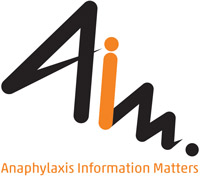|
|
Raising awareness about anaphylaxis – the AIM campaign and the NICE guidelines. |
Currently one in three of the UK population (21 million people) live with some kind of allergy and this number is increasing at an alarming rate (ii). Up to 7 million have an allergy severe enough to require specialist allergy care (v). Despite this, allergy services in the UK are massively underfunded, with a wide gap between patient need and service provision. In the NHS there are just 30 UK allergy specialists – which works out as one specialist per 700,000 patients. (vi) Anaphylaxis is the most severe allergic reaction and symptoms may include a raised skin rash, swelling of the mouth and tongue, throat tightening causing difficulties in breathing, fainting or collapsing which can result in cardiac arrest and death. This risk of anaphylaxis is significantly greater for people who have asthma as well allergy (vii). Common causes of anaphylaxis include foods such as peanuts (legumes), tree nuts (e.g. hazelnuts or cashews), sesame, fish, and shellfish dairy products and eggs. Non-food causes include insect stings from wasps or bees, penicillin and other medicines and natural latex (rubber). From April 2013 to February 2014, 20,318 hospital admissions had a primary diagnosis of allergy, a 7.7% increase on the previous 12 months. Twenty percent of admissions were for anaphylaxis, a 9.9% increase on the previous 12 months(i). As many as 1 in 5 people with allergy live in fear of death from anaphylaxis or an asthma attack (viii). Early treatment with an injection of adrenaline can be life-saving for those with very severe allergies but patients at risk need to be identified and well-prepared to recognise triggers and take appropriate action. Said Dr Andrew Clark, leading paediatric allergy Consultant from Addenbrooke’s Hospital in Cambridge: “The UK is experiencing a large increase in the number of people at risk of severe allergy and it is really important that these people to protect themselves. Healthcare professionals should take a full allergy history and, if the patient is at risk, they need referral to an Allergy Centre for a comprehensive management plan and a regular prescription for adrenaline auto injectors. Staying protected is vital and can be done by understanding the condition, identifying the triggers, avoiding the risks and knowing how and when to use the treatment.”
As part of AIM the Anaphylaxis Campaign has created a specific Primary Care programme to encourage healthcare professionals to be aware of the risks of severe allergy and anaphylaxis and follow the NICE QS – with the overall aim of reducing the number of anaphylaxis reactions. More information at www.anaphylaxis.org.uk (i) Health & Social Care Information Centre (HSCIC) Provisional Monthly Hospital Episode Statistics for Admitted Patient Care, Outpatients and Accident and Emergency Data - Apr 2013-Feb 2014. Publication: June 03, 2014 March 2016
If you found this article interesting, you will find many more articles on anaphylaxis here, and reports of research into anaphylaxis here.
|

 The Anaphylaxis Campaign is launching a new awareness programme –
The Anaphylaxis Campaign is launching a new awareness programme – 










